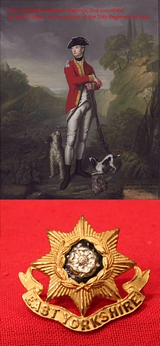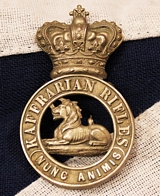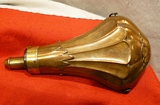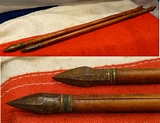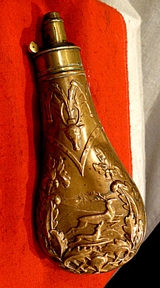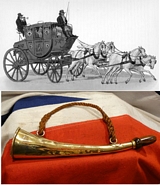Antique Arms & Militaria
A Very Fine East Yorkshire Regt. Officer's Cap badge
In gilt silver and enamel . Two fixing lugs. Raised in 1685 in Nottingham by Sir William Clifton, 3rd Baronet, it was originally, like many British infantry regiments, known by the name of its current Colonel. In 1751, when the numerical system of designation of Regiments of Foot was adopted, it became the 15th Regiment of Foot and in 1782 the 15th (The Yorkshire East Riding) Regiment of Foot. With the Childers Reforms of 1881, it became The East Yorkshire Regiment, the County Regiment of the East Riding of Yorkshire, and in 1935 was renamed The East Yorkshire Regiment (The Duke of York's Own), after its Colonel-in-Chief. In 1958, it was amalgamated with The West Yorkshire Regiment (The Prince of Wales's Own), to form The Prince of Wales's Own Regiment of Yorkshire.
It fought in the War of Spanish Succession, the Jacobite Rising of 1719 and in North America and the West Indies during the War of Jenkin's Ear, Seven Years' War and the American Revolutionary War including battles such as Capture of St. Lucia in 1778. It again fought in the West Indies during the Napoleonic Wars, taking part in the invasions of Martinique (1809) and Guadeloupe (1810).
The regiment spent most of the 19th century on garrison duty, both at home and throughout the Empire. The 1st Battalion was shipped to New Brunswick in 1862 at the time of the "Trent Affair", when Britain and the United States of America came close to war. The 2nd Battalion fought in the Second Anglo-Afghan War and the Second Boer War. Battle honours
Regimental colours; Blenheim, Ramillies, Oudenarde, Malplaquet, Louisburg, Quebec 1759, Martinique 1762, Havannah, St. Lucia 1778, Martinique 1794 1809, Guadeloupe 1810, Afghanistan 1879-80, South Africa 1900-02, The Great War (21 battalions): Aisne 1914 '18, Armenti?res 1914, Ypres 1915 '17 '18, Gravenstafel, St. Julien, Frezenberg, Bellewaarde, Hooge 1915, Loos, Somme 1916 '18, Albert 1916 '18, Bazentin, Delville Wood, Pozi?res, Flers-Courcelette, Morval, Thiepval, Ancre Heights, Ancre 1916, Arras 1917 '18, Scarpe 1917 '18, Arleux, Oppy, Messines 1917 '18, Pilckem, Langemarck 1917, Menin Road, Polygon Wood, Broodseinde, Poelcappelle, Passchendaele, Cambrai 1917 '18, St. Quentin, Bapaume 1918, Rosi?res, Lys, Estaires, Hazebrouck, Kemmel, Scherpenberg, Amiens, Hindenburg Line, ?p?hy, Canal du Nord, St. Quentin Canal, Selle, Sambre, France and Flanders 1914-18, Struma, Doiran 1917, Macedonia 1915-18, Suvla, Landing at Suvla, Scimitar Hill, Gallipoli 1915, Egypt 1915-16
The Second World War: Withdrawal to Escaut, Defence of Escaut, Defence of Arras, French Frontier 1940, Ypres-Comines Canal, Dunkirk 1940, Normandy Landing, Tilly sur Seulles, Odon, Caen, Bourgu?bus Ridge, Troarn, Mont Pincon, St. Pierre la Vielle, Gheel, Nederrijn, Aam, Venraij, Rhineland, Schaddenhof, Brinkum, Bremen, North-West Europe 1940 '44-45, Gazala, Mersa Matruh, Defence of Alamein Line, El Alamein, Mareth, Wadi Zigzaou, Akarit, North Africa 1942-43, Primosole Bridge, Sicily 1943, Sittang 1945, Burma 1945 read more
95.00 GBP
A Victorian Kaffrarian Rifles Badge, of South Africa, Motto "Nunc animus"
Nunc animus (meaning "Now with courage" or "Now without fear") This unit was formed in East London in 1876, as the Buffalo Corps of Rifle Volunteers, for service in the 9th Frontier War. It disbanded in 1879. (East London is situated on the Buffalo River, hence the name).
The unit was re-formed in July 1883 and was named after the region of Kaffraria, the 19th-century name for the region around East London. There had previously been many other units from this region, from which the Regiment can also claim descent: Kaffrarian Volunteer Corps, Kaffrarian Mounted Rifles (Kaffrarian Rangers), Buffalo Volunteer Rifles Corps, Buffalo Volunteer Engineers, Kaffrarian Volunteer Artillery Corps, Berlin Mounted Volunteers, Cape Mounted Yeomanry (1st Regiment), Frontier Mounted Riflemen (Brabant's Horse), East London Volunteers (Von Linsignen's Buffalo Corps and later Walkers Horse).
On 1 December 1900 George Herbert Farrar was appointed as a Major in the Kaffrarian Rifles.
In 1913 it was embodied in the Citizen Force as the 5th Infantry (Kaffrarian Rifles), but regained its old name in 1932. The unit was temporarily amalgamated with the First City Regiment, as the First City/The Kaffrarian Rifles from 1954 to 1956. In order to keep pace with the changing political climate in South Africa, the regiment was renamed the Buffalo Volunteer Rifles in 1999.
This Regiment and its predecessors took part in all of South Africa's armed conflicts, including the Bechuanaland Campaign (1897), the Second Boer War, World War I (when it fought in the then German South-West Africa and most of its members went on to serve in East Africa and Europe), World War II (when it fought in the Western Desert during 1941 - 1943 . 62 mm high read more
95.00 GBP
A Good 19th Century Powder Flask
Fluted copper body and brass adjustable spout. read more
175.00 GBP
A Good 19th Century Sykes Pistol Powder Flask
Absolutely ideal for pistol casing. A nice example with a few small dents. Small pistol flasks are certainly the most desireable type as they can beautifully set off a cased pistol set [and thus increase it's value dramatically], for either a flintlock or percussion gun, that is lacking it's original flask. 4.5 inches long read more
295.00 GBP
A Very Nice 19th Century Dixon & Son Pistol Powder Flask
In nice order with working spring spout with three adjustable gram measures. 4.75 inches long overall. A delightful piece with pressed shell pattern in copper with gilt spout. Super patina. read more
340.00 GBP
A Pair of Late 18th Early 19th Century Napoleonic Crossbow Pistol Bolts
Very finely made steel quarrel heads, beautifully facetted, with brass lined collars. On wooden hafts. Superbly made pieces and very scarce indeed. Illustrated with the kind of pistol used from the Napoleonic era. A weapon as silent as the grave, yet more deadly than a pistol as it's range was greater and penetrating power more effective. The heads could easily be beautifully polished to brighter steel. A picture in the gallery of a Napoleonic pistol that used such bolts. read more
135.00 GBP
A Very Fine. 19th Century Shaped Copper Powder Flask
With good adjustable spout measure and tight spring. read more
195.00 GBP
A Good French Boche Powder Flask, 19th Century, Shell Pattern
By Boche of Paris, a fine quality flask with good working spring action. Boche apparently signed only his best examples and flasks by Boche belong to the highest in society. read more
195.00 GBP
A Fine Victorian G & J W Hawksley Powder Flask
A very good copper and brass powder flask for a gun with the oak leaf design incorporating a fox and stag head, the nozzle stamped Drams and graduation values of 2?, 2?, 2? , the nozzle signed G & J. W. Hawksley, slight dent one side at the top of the body, and in working order. Overall 8 by 3? inches.
See THE POWDER FLASK BOOK, Ray Riling page 315 fig 580.
Riling says in the book that the flask illustrated as fig 580 was made by Hawksley for Barton of New York and implies that this was an exclusive design to them and does not mention having seen one marked Hawksley which might suggest that this is rare. read more
225.00 GBP
A Most Interesting French Post Chaise Horn. Brass Trumpet, Horn Mouthpiece.
19th century. In France and Switzerland in the Alp regions, as the post chaise drives around the numerous deadly bends, on the mountain passes, in the fog, the post chaise horn is blown to warn on-coming vehicles. Of course the British poste chaise used them as well but this one is French made. A post chaise, is a four-wheeled, closed carriage, containing one seat for two or three passengers, that was popular in 18th-century England and France. The body was of the coup? type, appearing as if the front had been cut away. Because the driver rode one of the horses, it was possible to have windows in front as well as at the sides. At the post chaise?s front end, in place of the coach box, was a luggage platform. The carriage was built for long-distance travel, and so horses were changed at intervals at posts (stations).In England, public post chaises were painted yellow and could be hired, along with the driver and two horses, for about a shilling a mile. The post chaise is descended from the 17th-century two-wheeled French chaise. read more
125.00 GBP


